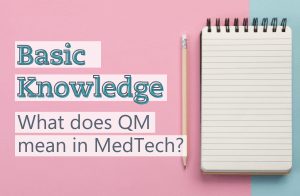Basics: What Does Quality Management Mean in Medical Technology?
07/11/2022
Do you have any questions about the article or would you like to find out more about our services? We look forward to hearing from you!Make a non-binding enquiry now
Quality management is required by regulatory requirements and is implemented by all medical devices manufacturers and in-vitro diagnostics (IVDs) manufacturers: How can you make sensible use of your existing QM landscape to make the quality management of your medical devices and in-vitro diagnostics even more efficient? We will be happy to explain the various approaches to optimizing your quality management system. We support you as a manufacturer, importer, distributor or supplier of medical devices and IVDs in offering and implementing high quality.
Product quality requirements
When we speak of quality, we associate various aspects: Product quality, for example, is the quality that a medical device or IVD must have to meet certain requirements.Generally, the term "quality" is defined in ISO 9000:2015-11 as "the degree to which a set of inherent characteristics of an object fulfills requirements. " Objectively measurable characteristics are used to ensure whether, for example, a medical device meets the existing quality requirements. Depending on how many of these requirements are met, a product can be of high or low quality. Quality management is an important tool to ensure consistently high quality of your medical devices and IVDs at the product level to meet normative and regulatory requirements.Focus not only on the quality of the final product. Quality begins in your QM system from the first idea of the product and runs through all QM processes until the product is ready to be placed on the market. Let us take a closer look at your QM system processes together and improve them so that the gears of your QM system mesh smoothly.Quality requirements for medical devices and IVDs.
Due to the regulatory requirements of the MDR and IVDR, quality is a high priority. Additionally, the medical technology field is subject to specialized standards specifically applicable to medical devices and IVDs: ISO 13485 for quality management systems is now indispensable, and the (EU) Regulation 2017/745 MDR as well as the (EU) Regulation 2017/746 IVDR requires medical device and in-vitro diagnostics (IVDs) manufacturers to implement a QM system.Implement quality in your company with the support of ISO 13485. The standard sets specific requirements for manufacturers, - also with regard to the use of software - for development, production, service provision, management, suppliers, testing and measuring equipment used, product and process monitoring, and the regular review of the entire system.Does your quality management system meet all requirements?
A functioning quality management system is a prerequisite for product quality. This system considers regulatory requirements, as well as the demands of patients, users, and third parties. A QM system features capable and stable processes that prevent the recurrence of errors. The quality of a medical device or IVD can be considered good when it meets the needs and requirements of the target market.Meeting internal and external requirements starts with an idea—an idea for a product, passion for design, functionality, and quality. In the field of medical devices, you can achieve this with ISO 13485 and implement it through the development process. In this process, you normatively and regulatorily discuss and analyze your customers' and the market's requirements, mapping them through subprocesses.To achieve high product quality for your medical devices or IVDs, it is essential to consider the quality of internal (QM) processes. A process is generally defined as a systematic and business-like progression or development. This includes the development and manufacturing process, covering all activities up to the finished product. Stable and capable QM processes are important for manufacturers to ensure consistent results.What about changes to medical devices/IVDs?
The development and manufacturing process is not the only factor in the quality of the final product. If your product exhibits a non-conformity or incident, it is essential to have an efficient and stress-resistant process for corrective and preventive actions (CAPA). The quality of your product is significantly determined by how you manage changes in development and the product itself. The CAPA process intervenes in your product realization if there are issues with product quality. Management processes such as management review and internal audits play an important role in making sustainable use of the findings from a non-conformity.Speaking of internal audits—when was the last time you thoroughly examined your QM system? This is where your greatest potential lies, not only to install processes conforming to regulatory requirements but also to evaluate their efficiency. A smart QM system saves time and money and ultimately reflects in product quality.How your QM system can benefit from the digitization of medical devices
ISO 13485, as mentioned, sets requirements for QM system processes, including the validation of software used from the design phase to product realization and beyond, throughout the lifecycle of medical devices and IVDs. These include, for example:- Digital signatures,
- Document management,
- Supplier management,
- Test equipment management,
- CAPA management,
- Training and Qualification management,
- Risk management software,
- Regulatory information systems for creating submission files, and
- PMS software that represents the PMS process or supports the search for literature and incidents.
Conclusion
ISO 13485 provides you with a solid foundation upon which you can build your QM system. A good QM system allows you to quickly identify and correct error-prone processes. Good QM processes increase customer satisfaction and save time, resources, and internal costs. Don’t waste time! Check your quality management system for weak points and optimize your processes to the best of your ability.Have you updated your QM system to current standards, or do you have questions about the implementation of a quality management system in your company? Our QM team is here to provide you with the support you need.We look forward to getting to know you!This article was originally written by Bruntje Schmidt and Nadine Potstawa. If you have any questions about this article or anything else, please do not hesitate to contact Bruntje Schmidt.
Our blog posts are researched and created with the utmost care, but are only snapshots of the regulations, which are constantly changing. We do not guarantee that older content is still current or meaningful. If you are not sure whether the article you have read on this page still corresponds to the current state of regulation, please contact us: we will quickly place your topic in the current context.



